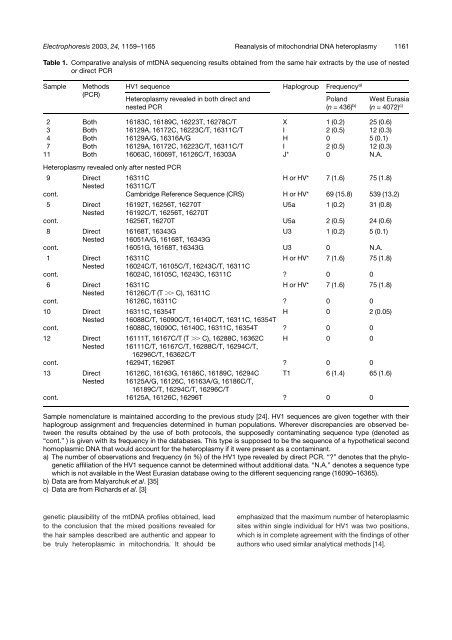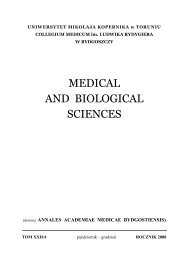High levels of mitochondrial DNA heteroplasmy in single hair roots ...
High levels of mitochondrial DNA heteroplasmy in single hair roots ...
High levels of mitochondrial DNA heteroplasmy in single hair roots ...
You also want an ePaper? Increase the reach of your titles
YUMPU automatically turns print PDFs into web optimized ePapers that Google loves.
Electrophoresis 2003, 24, 1159–1165 Reanalysis <strong>of</strong> <strong>mitochondrial</strong> <strong>DNA</strong> <strong>heteroplasmy</strong> 1161<br />
Table 1. Comparative analysis <strong>of</strong> mt<strong>DNA</strong> sequenc<strong>in</strong>g results obta<strong>in</strong>ed from the same <strong>hair</strong> extracts by the use <strong>of</strong> nested<br />
or direct PCR<br />
Sample<br />
Methods<br />
(PCR)<br />
HV1 sequence Haplogroup Frequency a)<br />
Heteroplasmy revealed <strong>in</strong> both direct and<br />
nested PCR<br />
Poland West Eurasia<br />
(n = 436) b) (n = 4072) c)<br />
2 Both 16183C, 16189C, 16223T, 16278C/T X 1 (0.2) 25 (0.6)<br />
3 Both 16129A, 16172C, 16223C/T, 16311C/T I 2 (0.5) 12 (0.3)<br />
4 Both 16129A/G, 16316A/G H 0 5 (0.1)<br />
7 Both 16129A, 16172C, 16223C/T, 16311C/T I 2 (0.5) 12 (0.3)<br />
11 Both 16063C, 16069T, 16126C/T, 16303A J* 0 N.A.<br />
Heteroplasmy revealed only after nested PCR<br />
9 Direct 16311C H or HV* 7 (1.6) 75 (1.8)<br />
Nested 16311C/T<br />
cont. Cambridge Reference Sequence (CRS) H or HV* 69 (15.8) 539 (13.2)<br />
5 Direct 16192T, 16256T, 16270T U5a 1 (0.2) 31 (0.8)<br />
Nested 16192C/T, 16256T, 16270T<br />
cont. 16256T, 16270T U5a 2 (0.5) 24 (0.6)<br />
8 Direct 16168T, 16343G U3 1 (0.2) 5 (0.1)<br />
Nested 16051A/G, 16168T, 16343G<br />
cont. 16051G, 16168T, 16343G U3 0 N.A.<br />
1 Direct 16311C H or HV* 7 (1.6) 75 (1.8)<br />
Nested 16024C/T, 16105C/T, 16243C/T, 16311C<br />
cont. 16024C, 16105C, 16243C, 16311C ? 0 0<br />
6 Direct 16311C H or HV* 7 (1.6) 75 (1.8)<br />
Nested 16126C/T (T .. C), 16311C<br />
cont. 16126C, 16311C ? 0 0<br />
10 Direct 16311C, 16354T H 0 2 (0.05)<br />
Nested 16088C/T, 16090C/T, 16140C/T, 16311C, 16354T<br />
cont. 16088C, 16090C, 16140C, 16311C, 16354T ? 0 0<br />
12 Direct 16111T, 16167C/T (T .. C), 16288C, 16362C H 0 0<br />
Nested 16111C/T, 16167C/T, 16288C/T, 16294C/T,<br />
16296C/T, 16362C/T<br />
cont. 16294T, 16296T ? 0 0<br />
13 Direct 16126C, 16163G, 16186C, 16189C, 16294C T1 6 (1.4) 65 (1.6)<br />
Nested 16125A/G, 16126C, 16163A/G, 16186C/T,<br />
16189C/T, 16294C/T, 16296C/T<br />
cont. 16125A, 16126C, 16296T ? 0 0<br />
Sample nomenclature is ma<strong>in</strong>ta<strong>in</strong>ed accord<strong>in</strong>g to the previous study [24]. HV1 sequences are given together with their<br />
haplogroup assignment and frequencies determ<strong>in</strong>ed <strong>in</strong> human populations. Wherever discrepancies are observed between<br />
the results obta<strong>in</strong>ed by the use <strong>of</strong> both protocols, the supposedly contam<strong>in</strong>at<strong>in</strong>g sequence type (denoted as<br />
“cont.” ) is given with its frequency <strong>in</strong> the databases. This type is supposed to be the sequence <strong>of</strong> a hypothetical second<br />
homoplasmic <strong>DNA</strong> that would account for the <strong>heteroplasmy</strong> if it were present as a contam<strong>in</strong>ant.<br />
a) The number <strong>of</strong> observations and frequency (<strong>in</strong> %) <strong>of</strong> the HV1 type revealed by direct PCR. “?” denotes that the phylogenetic<br />
affiliation <strong>of</strong> the HV1 sequence cannot be determ<strong>in</strong>ed without additional data. “N.A.” denotes a sequence type<br />
which is not available <strong>in</strong> the West Eurasian database ow<strong>in</strong>g to the different sequenc<strong>in</strong>g range (16090–16365).<br />
b) Data are from Malyarchuk et al. [35]<br />
c) Data are from Richards et al. [3]<br />
genetic plausibility <strong>of</strong> the mt<strong>DNA</strong> pr<strong>of</strong>iles obta<strong>in</strong>ed, lead<br />
to the conclusion that the mixed positions revealed for<br />
the <strong>hair</strong> samples described are authentic and appear to<br />
be truly heteroplasmic <strong>in</strong> mitochondria. It should be<br />
emphasized that the maximum number <strong>of</strong> heteroplasmic<br />
sites with<strong>in</strong> s<strong>in</strong>gle <strong>in</strong>dividual for HV1 was two positions,<br />
which is <strong>in</strong> complete agreement with the f<strong>in</strong>d<strong>in</strong>gs <strong>of</strong> other<br />
authors who used similar analytical methods [14].

















